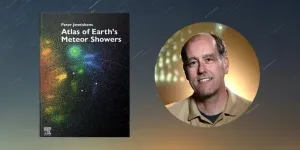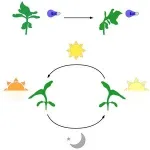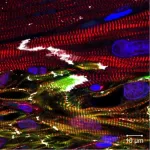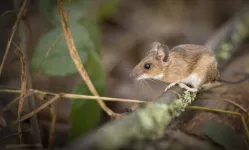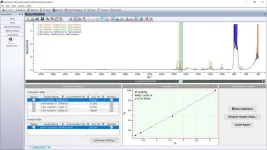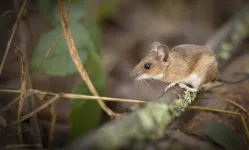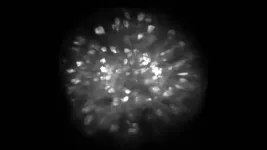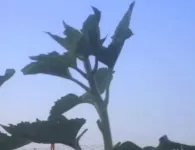(Press-News.org) The First ‘Birder’s Guide’ to Meteor Showers
Peter Jenniskens new comprehensive guide describes over 500 meteor showers that appear in our night skies.
October 31, 2023, Mountain View, CA -- The SETI Institute is proud to announce a new book by SETI Institute meteor astronomer Dr. Peter Jenniskens. Called “Atlas of Earth’s Meteor Showers,” this comprehensive guide describes over 500 meteor showers that appear in our night skies and adds a wealth of detail to the tapestry of our solar system.
“Just as in a birder’s guide, the book describes the outward appearance, range, season, rarity, and physical characteristics of each meteor shower,” said Jenniskens. “Some showers are around every year; others are only occasional visitors.”
Those who spend an hour watching the clear sky at night, warmly dressed and seated on a reclining lawn chair in a dark location, will be rewarded with the spectacle of meteors at an average rate of ten or so per hour, more so in the predawn hours.
At certain times in the year, there are more than others due to meteor showers that occur when Earth passes through streams of meteoroids from comets and primitive asteroids.
“Meteor showers are important because these streams of meteoroids can hit satellites in Earth orbit at astronomical speeds, and they point to the presence of dangerous long-period comets that can impact Earth,” said Jenniskens. “Meteor showers are also a historical document of past comet orbit evolution and decay.”
The new book is the culmination of over a decade of monitoring the night skies with low-light video security camera networks from locations worldwide. Jenniskens is the Principaln Investigator of one of these networks called CAMS, the NASA-sponsored Cameras for Allsky Meteor Surveillance project.
“The CAMS project deploys over 600 cameras at 15 sites in ten countries all over the world, operated by both professional and amateur astronomers and institutes”, said Jenniskens. “All together, we have now triangulated over 2.7 million meteors to measure their direction and speed, and from that calculated on which orbit the meteoroids approached Earth.”
The “Atlas” combines CAMS data with the video observations of other networks and with radar observations of meteor showers to show from what directions meteoroids of different sizes impact Earth. These contributions resulted in the creation of over 400 maps showing meteor showers throughout the year.
“About half of known showers originate from long-period comets. Because they often come in at high speed, video cameras and the naked eye best detect those showers,” said Jenniskens. “Only 26 out of 500 showers are so rich in small particles that they are only detected by radar.”
For each shower, CAMS measured how high in the atmosphere the meteors were first detected, how they brightened and faded, and how quickly they were slowed down by the atmosphere. From that, each shower was described in activity, orbit and duration but also by the physical properties of their meteoroids.
“The light of just over one thousand meteors were analyzed for telltale emissions from sodium, iron and magnesium atoms, the resulting compositions of which were added to the shower descriptions,” said Jenniskens. “Loss of sodium and low beginning heights show what fraction of matter was physically changed by heat or cosmic ray radiation.”
The book also summarizes previously published meteor shower studies, adding new details.
“We added to published work on short-period showers the approximate ages of long period comet showers from calculations performed here at the SETI Institute,” said SETI Institute astronomer Stu Pilorz, who collaborated with Jenniskens on this work.
The book presents an unparalleled dataset to explore for understanding the conditions under which meteoroids depart from comets and what happens to them afterward.
“But the real joy for me is that we can identify now the meteor showers you see when watching the night sky on your next camping trip,” said Jenniskens. “And hopefully help you spot some of those irregular visitors to make this a big year.”
The video surveillance of the night sky is ongoing to catch these rare irregular meteor showers.
Publisher Elsevier website: https://shop.elsevier.com/books/atlas-of-earths-meteor-showers/jenniskens/978-0-323-88447-1
CAMS data visualization websites:
http://cams.seti.org/FDL/
https://meteorshowers.seti.org
About the SETI Institute
Founded in 1984, the SETI Institute is a non-profit, multi-disciplinary research and education organization whose mission is to lead humanity’s quest to understand the origins and prevalence of life and intelligence in the universe and share that knowledge with the world. Our research encompasses the physical and biological sciences and leverages data analytics, machine learning, and advanced signal detection technologies. The SETI Institute is a distinguished research partner for industry, academia, and government agencies, including NASA and the National Science Foundation.
END
The first ‘birder’s guide’ to meteor showers
Peter Jenniskens new comprehensive guide describes over 500 meteor showers that appear in our night skies.
2023-10-31
ELSE PRESS RELEASES FROM THIS DATE:
Better access to diagnostic tests raises incidence of thyroid cancer in more affluent areas
2023-10-31
The incidence of thyroid cancer in São Paulo State, part of Brazil’s relatively developed Southeast region, varies considerably according to socioeconomic status (education, poverty, wealth, income, segregation, mobility, and access to resources and services) and access to screening, but is highest in higher-income areas and the state capital. Mortality rates are similar across regions and income groups, however.
These are the main findings of a study reported in the journal Endocrine Practice by researchers ...
Combining cell types may lead to improved cardiac cell therapy following heart attack
2023-10-31
Researchers at the University of Wisconsin–Madison and Academia Sinica of Taiwan have harnessed a combination of lab-grown cells to regenerate damaged heart muscle.
The study, published in Circulation — which addresses major challenges of using heart muscle cells, called cardiomyocytes, grown from stem cells — takes a crucial step toward future clinical applications.
Previous research has shown that transplanting cardiomyocytes made from induced pluripotent stem cells (iPSC) can replace muscle in the hearts of mammals. Researchers have struggled to bring the treatment to the clinic, in part because the implanted cells haven’t developed enough ...
Cary Institute to co-lead $4.8 million study on how environmental conditions shape viral outbreaks in wild rodents
2023-10-31
When, where, and why do diseases jump from animals to people? A new project will monitor how changing seasons, land use, and human behavior influence viral outbreaks in wild rodent populations, to identify hotspots with high potential for spillover into people. The project is co-led by Barbara Han, a disease ecologist at Cary Institute of Ecosystem Studies, in an international team of scientists from the Smithsonian Institution, Royal Veterinary College, Oxford University, and the University of ...
Wiley announces the release of KnowItAll 2024 with new multi-technique quantitation tool and additional advances for spectral analysis workflows
2023-10-31
Hoboken, NJ — October 31, 2023 — Wiley, a knowledge company and global leader in research, publishing and knowledge solutions, today announced the release of the KnowItAll 2024 Analytical Edition, the latest version of its spectral software that offers solutions to analyze, identify, quantify, and manage analytical and chemical data.
When it comes to chemical quantitative analysis, researchers often find themselves navigating multiple software packages. Mastering multiple software packages to achieve the same level of expertise, reproducibility, and ...
Cary Institute to co-lead $4.8M study on how environmental conditions shape RNA virus outbreaks in wild rodents
2023-10-31
When, where, and why do diseases jump from animals to people? A new project will monitor how changing seasons, land use, and human behavior influence viral outbreaks in wild rodent populations, to identify hotspots with high potential for spillover into people. The project is co-led by Barbara Han, a disease ecologist at Cary Institute of Ecosystem Studies, in an international team of scientists from the Smithsonian Institution, Royal Veterinary College, Oxford University, and the University of Glasgow.
Until now, it has been difficult to study how changing environmental conditions impact virus transmission in the wild. With $2.9 million in funding ...
For the sunflower, turning toward the sun requires multiple complex systems
2023-10-31
A sunflower’s ability to track the sun east to west during the day, and to face east again before the next sunrise, relies on multiple types of photoresponses, according to a new study publishing October 31st in the open access journal PLOS Biology by Stacey Harmer and colleagues at the University of California Davis, US. The results deepen the understanding of this well-known plant behavior, and upend previous assumptions about its dependence on a canonical light-dependent response pathway.
Because plants are ...
Smells like learning
2023-10-31
Order wine at a fancy restaurant, and the sommelier might describe its aroma as having notes of citrus, tropical fruit, or flowers. Yet, when you take a whiff, it might just smell like … wine. How can wine connoisseurs pick out such similar scents?
Cold Spring Harbor Laboratory (CSHL) Associate Professor Saket Navlakha and Salk Institute researcher Shyam Srinivasan may have the answer. They have found that certain neurons allow fruit flies and mice to tell apart distinct smells. The team ...
How sunflowers see the sun
2023-10-31
Sunflowers famously turn their faces to follow the sun as it crosses the sky. But how do sunflowers “see” the sun to follow it? New work from plant biologists at the University of California, Davis, published Oct. 31 in PLOS Biology, shows that they use a different, novel mechanism from that previously thought.
“This was a total surprise for us,” said Stacey Harmer, professor of plant biology at UC Davis and senior author on the paper.
Most plants show phototropism – the ability to grow toward a ...
Climate-smart cows could deliver 10-20x more milk in Global South
2023-10-31
URBANA, Ill. — A team of animal scientists from the University of Illinois Urbana-Champaign is set to deliver a potential game changer for subsistence farmers in Tanzania: cows that produce up to 20 times the milk of indigenous breeds.
The effort, published in Animal Frontiers, marries the milk-producing prowess of Holsteins and Jerseys with the heat, drought, and disease-resistance of Gyrs, an indigenous cattle breed common in tropical countries. Five generations of crosses result in cattle capable of ...
SARS-CoV-2 infection affects energy stores in the body, study shows
2023-10-31
CHAPEL HILL, N.C. – The lungs were once at the forefront of SARS-Cov-2 research, but as reports of organ failure and other serious complications poured in, scientists set out to discover how and why the respiratory virus was causing serious damage to the body's major organs, including the lungs.
An interdisciplinary COVID-19 International Research Team (COV-IRT), which includes UNC School of Medicine’s Jonathan C. Schisler, PhD, found that SARS-CoV-2 alters mitochondria on a genetic ...
LAST 30 PRESS RELEASES:
There are new antivirals being tested for herpesviruses. Scientists now know how they work
CDI scientist, colleagues author review of global burden of fungus Candida auris
How does stroke influence speech comprehension?
B cells transiently unlock their plasticity, risking lymphoma development
Advanced AI dodel predicts spoken language outcomes in deaf children after cochlear implants
Multimodal imaging-based cerebral blood flow prediction model development in simulated microgravity
Accelerated streaming subgraph matching framework is faster, more robust, and scalable
Gestational diabetes rose every year in the US since 2016
OHSU researchers find breast cancer drug boosts leukemia treatment
Fear and medical misinformation regarding risk of progression or recurrence among patients with breast cancer
Glucagonlike peptide-1 receptor agonists and asthma risk in adolescents with obesity
Reviving dormant immunity: Millimeter waves reprogram the immunosuppressive microenvironment to potentiate immunotherapy without obvious side effects
Safety decision-making for autonomous vehicles integrating passenger physiological states by fNIRS
Fires could emit more air pollution than previously estimated
A new way to map how cells choose their fate
Numbers in our sights affect how we perceive space
SIMJ announces global collaborative book project in commemoration of its 75th anniversary
Air pollution exposure and birth weight
Obstructive sleep apnea risk and mental health conditions among older adults
How talking slows eye movements behind the wheel
The Ceramic Society of Japan’s Oxoate Ceramics Research Association launches new international book project
Heart-brain connection: international study reveals the role of the vagus nerve in keeping the heart young
Researchers identify Rb1 as a predictive biomarker for a new therapeutic strategy in some breast cancers
Survey reveals ethical gaps slowing AI adoption in pediatric surgery
Stimulant ADHD medications work differently than thought
AI overestimates how smart people are, according to HSE economists
HSE researchers create genome-wide map of quadruplexes
Scientists boost cell "powerhouses" to burn more calories
Automatic label checking: The missing step in making reliable medical AI
Low daily alcohol intake linked to 50% heightened mouth cancer risk in India
[Press-News.org] The first ‘birder’s guide’ to meteor showersPeter Jenniskens new comprehensive guide describes over 500 meteor showers that appear in our night skies.
